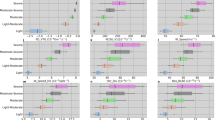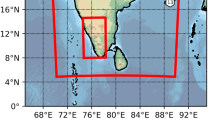Abstract
This research investigates the efficacy of the cloud-resolving Weather Research and Forecasting (WRF) model in reproducing convective cells associated with flash-flooding heavy rainfall near Peja, Northeast Kosovo, on June 24, 2023. Employing two distinct dynamical cores and a unique numerical setup for the Kosovo domain, numerical experiments were conducted. The study employed a triply nested WRF-ARW model with a high resolution of 3 km horizontal grid spacing, integrating conventional analysis data. Additionally, experiments using the WRF-NMM core with 3 km for a larger domain covering Southeast Europe and Kosovo domain were executed to simulate the specific event. The WRF model accurately simulated the initiation of isolated thunderstorms, convective band formation, cloud cluster, and squall line at the opportune time. While precipitation distribution was reasonably replicated, there was a slight underestimation in the amount. Hydrological analysis of precipitation, including river discharge rates provided from ECMWF ERA5 reanalysis, identified a unique storm category with intense precipitation production, registering an intensity of approximately 54.6 mm in 1 h, leading to sudden flash flooding.












Similar content being viewed by others
References
Chawla I, Osuri KK, Mujumdar PP, Niyogi D (2018) Assessment of the weather research and forecasting (WRF) model for simulation of extreme rainfall events in the upper Ganga Basin. Hydrol Earth Syst Sci 22:1095–1117
Chinta S, Yaswanth SJ, Balaji C (2021) Assessment of WRF model parameter sensitivity for high-intensity precipitation events during the Indian summer monsoon. Earth Space Sci. https://doi.org/10.1029/2020ea001471
Cloke H, Pappenberger F, Thielen J, Thiemig V (2013) In operational european flood forecasting. In: Wainwright J, Mulligan M (eds) Environmental modelling: finding simplicity in complexity, 2nd edn. Wiley, London
Cluckie ID, Han D (2000) Fluvial flood forecasting. Water Environ J 14(4):270–276
Collier CG (2007) Flash flood forecasting: what are the limits of predictability? Q J R Meteorol Soc J Atmos Sci Appl Meteorol Phys Oceanogr 133(622):3–23
da Cunha Luz Barcellos P, Cataldi M (2020) Flash flood and extreme rainfall forecast through one-way coupling of wrf-SMAP models: natural hazards in Rio de Janeiro State. Atmosphere 11(8):834. https://doi.org/10.3390/atmos11080834
Dudhia J (1989) Numerical study of convection observed during the Winter Monsoon experiment using a mesoscale two-dimensional model. J Atmos Sci 46:3077–3107
Elmore KL, Stensrud DJ, Crawford KC (2002) Ensemble cloud model applications to forecast Thunderstorms. J Appl Meteorol Climatol 41:363–383. https://doi.org/10.1175/1520-0450(2002)041%3c0363:ECMATF%3e2.0.CO;2
Emerton RE, Stephens EM, Pappenberger F, Pagano TP, Weerts AH, Wood A et al (2016) Continental and global scale flood forecasting systems. Wiley Interdiscip Rev Water 3(3):391–418. https://doi.org/10.1002/wat2.1137
Gao Y, Leung LR, Zhao C, Hagos S (2017) Sensitivity of U.S. summer precipitation to model resolution and convective parameterizations across gray zone resolutions. J Geophys Res Atmos 122:2714–2733
Gevorgyan A (2018) Convection-permitting simulation of a heavy rainfall event in Armenia using the WRF model. J Geophys Res Atmos 123:11008–11029
Giannaros C, Dafis S, Stefanidis S, Giannaros TM, Koletsis I, Oikonomou C (2023) Hydrometeorological analysis of a flash flood event in an ungauged Mediterranean watershed under an operational forecasting and monitoring context. Meteorol Appl 29:e2079
Han JY, Hong SY (2018) Precipitation forecast experiments using the weather research and forecasting (WRF) model at gray-zone resolutions. Weather Forecast 33:1605–1616
Hapuarachchi HAP, Wang QJ, Pagano TC (2011) A review of advances in flash flood forecasting. Hydrol Process 25:2771–2784
Hong SY (2010) A new stable boundary layer mixing scheme and its impact on the simulated East Asian summer monsoon. Quart J Roy Meteor Soc 136(651):1481–1496. https://doi.org/10.1002/Qj.665
Hong SY, Lee JW (2009) Assessment of the WRF model in reproducing a flash-flood heavy rainfall event over Korea. Atmos Res 93:818–831
Janjic ZI (2003) A non-hydrostatic model based on a new approach. Meteorol Atmos Phys 82:271–285
Janjic ZI (1996) The surface layer in the NCEP Eta Model. In: Eleventh conference on numerical weather prediction, 19–23 August, Norfolk, VA, American Meteorological Society, Boston, pp 354–355
Kain JS, Weiss SJ, Levit JJ, Baldwin ME, Bright DR (2006) Examination of convection-allowing configurations of the WRF-NMM model for the prediction of severe convective weather: the SPC/ NSSL Spring Program 2004. Weather Forecast 21:167–181
Lee JW, Hong SY (2006) A numerical simulation study of orographic effects for a heavy rainfall event over Korea using the WRF model. Atmosphere 16:319–332
Lee DK, Kim HR, Hong SY (1998) Heavy rainfall over Korea during 1980–1990. Korean J Atmos Sci 1:32–50
Lekhadiya HS, Jana RK (2018) Analysis of extreme rainfall events with different microphysics and parameterization schemes in the WRF model. Positioning 9:1–11
Levit JJ, Baldwin ME, Bright DR (2006) Examination of convective allowing configurations of the WRF-NMM model for the prediction of severe convective weather: the SPC/NSSL spring program 2004. Weather Forecast 21:167–181
Litta AJ, Mary IS, Mohanty UC, Kiran PS (2012) Comparison of thunderstorm simulations from WRF-NMM and WRF-ARW models over East Indian Region. Sci World J 2012:951870
Merino A, García-Ortega E, Navarro A, Sánchez JL, Tapiador FJ (2022) WRF hourly evaluation for extreme precipitation events. Atmos Res 274:106215
Misenis C, Zhang Y (2010) An examination of the sensitivity of WRF/Chem predictions to physical parameterizations, horizontal grid spacing, and nesting options. Atmos Res 97:315–334
Mlawer EJ, Taubman SJ, Brown PD, Iacono MJ, Clough SA (1997) Radiative transfer for inhomogeneous atmospheres: RRTM, a validated correlated-k model for the longwave. J Geophys Res 102D:16663–16682. https://doi.org/10.1029/97JD00237
Mohanty U, Routray A, Osuri KK, Prasad SK (2012) A study on simulation of heavy rainfall events over Indian region with ARW 3DVAR modeling system. Pure Appl Geophys 169:381–399
Moya AS, Martínez-Castro D, Flores JL, Silva Y (2018) Sensitivity study on the influence of parameterization schemes in WRF_ARW model on short- and medium-range precipitation forecasts in the Central Andes of Peru. Adv Meteorol 2018:1–16. https://doi.org/10.1155/2018/1381092
Schwartz C, Glen R, Ryan S, Fossell K, Weisman M (2015) NCAR’s experimental real-time convection-allowing ensemble prediction system. Weather Forecast 30:150904135422005. https://doi.org/10.1175/WAF-D-15-0103.1
Schwartz CS, Romine GS, Weisman ML, Sobash RA, Fossell KR, Manning KW, Trier SB (2015b) A real-time convection-allowing ensemble prediction system initialized by mesoscale ensemble Kalman filter analyses. Wea Forecast 30:1158–1181. https://doi.org/10.1175/WAF-D-15-0013.1
Shin HH, Hong SY (2011) Intercomparison of planetary boundary-layer parametrizations in the WRF model for a single day from CASES-99. Bound Layer Meteorol 139:261–281
Shin H, Hong SY (2015) Representation of the subgrid-scale turbulent transport in convective boundary layers at gray-zone resolutions. Mon Weather Rev 143:250–271
Skamarock WC, Klemp JB (2008) A time-split non-hydrostatic atmospheric model for weather 938 research and forecasting applications. J Comput Phys 227(7):3465–3485
Skamarock WC, Weisman ML, Klemp JB (1994) Three-dimensional evolution of simulated long-lived squall lines. J Atmos Sci 51:2563–2584
Skamarock WC, Klemp JB, Dudhia J et al (2008b) A description of the advanced research WRF version 3 (No. NCAR/TN-475+STR). University Corporation for Atmospheric Research. https://doi.org/10.5065/D68S4MVH
Sofiati I, Nurlatifah A (2019) The prediction of rainfall events using the WRF (weather research and forecasting) model with ensemble technique. Int Conf Ser Earth Environ Sci 374:12036
Song HJ, Sohn BJ (2018) An evaluation of WRF microphysics schemes for simulating the warm-type heavy rain over the Korean Peninsula. J Atmos Sci 54(2):225–236
Spiridonov V, Ćurić M (2019) Evaluation of Supercell storm triggering factors based on a cloud-resolving model simulation. Asia Pac J Atmos Sci 55:439–458
Spiridonov V, Baez J, Telenta JB (2020) Prediction of extreme convective rainfall intensities using a free-running 3-D sub-km-scale cloud model initialized from WRF km-scale NWP forecasts. J Atmos Solar-Terr Phys 209:105401. https://doi.org/10.1016/j.jastp.2020.105401
Spiridonov V, Ćurić M, Grčić M et al (2023) Assessment of the WRF model in simulating a catastrophic flash flood. Acta Geophys 71:1347–1359. https://doi.org/10.1007/s11600-023-01032-5
Sun C, Liang XZ (2020) Improving US extreme precipitation simulation: sensitivity to physics parameterizations. Clim Dyn 54(11–12):4891–4918
Sun J, Lee TY (2002) A numerical study of an intense quasi-stationary convection band over the Korean Peninsula. J Meteorol Soc Japan 80:1221–1245
Thielen J, Bartholmes J, Ramos M-H, De Roo A (2009a) The European flood alert system part 1: concept and development. Hydrol Earth Syst Sci 13(2):125–140. https://doi.org/10.5194/hess-13-125-2009
Thielen J, Bogner K, Pappenberger F, Kalas M, Del Medicoa M, de Rooa A (2009) Monthly-, medium-, and short-range flood warning: Testing the limits of predictability. Meteorol Appl 16(1):77–90. https://doi.org/10.1002/met.140
Thompson G, Eidhammer T (2014) A study of aerosol impacts on clouds and precipitation development in a large winter cyclone. J Atmos Sci 71(10):3636–3658. https://doi.org/10.1175/JAS-D-13-0305.1
Umer Y, Ettema J, Jetten V, Steeneveld G-J, Ronda R (2021) Evaluation of the WRF model to simulate a high-intensity rainfall event over Kampala, Uganda. Water 13:873. https://doi.org/10.3390/w13060873
Varlas G, Papaioannou G, Papadopoulos A, Markogianni V, Vardakas L, Dimitriou E (2023) Flash flood forecasting using integrated meteorological–hydrological–hydraulic modeling: application in a mediterranean river. Environ Sci Proc 26(1):35. https://doi.org/10.3390/environsciproc2023026035
Xue M, Kong F, Thomas KW, Gao J, Wang Y, Brewster K, Droegemeier KK, Kain JS, Bright SJDR, Coniglio MC, Du J (2008) CAPS real-time storm-scale ensemble and high-resolution forecasts as part of the NOAA Hazardous Weather Testbed 2008 Spring Experiment. In: Preprints, 24th conference on severe local storms, Amer. Meteor. Soc., Savannah, GA. CD-ROM 12.2
Zaldi SM, Gisen JIA, Eltahan M, Yu Q, Misbari S, Ngien SK (2022) Assessment of weather research and forecasting (WRF) physical schemes parameterization to predict moderate to extreme rainfall in poorly gauged basin. Sustainability 14(19):12624. https://doi.org/10.3390/su141912624
Zhang DL, Gao K, Parsons DB (1989) Numerical simulation of an intense squall line during 10–11 June 1985 PRE-STORM. Part I: model verification. Mon Weather Rev 117:960–994
Zheng Y, Xue M, Li B, Chen J, Tao Z (2016) Spatial characteristics of extreme rainfall over China with hourly through 24-hour accumulation periods based on national-level hourly rain gauge data. Adv Atmos Sci 33:1218–1232
Acknowledgements
We express our sincere appreciation to the Hydrometeorological Institute of Kosovo for their generous provision of precipitation data and daily rainfall distribution for the case study event. Our gratitude extends to the Faculty of Computer Science and Engineering (FINKI) for the invaluable access granted to advanced computing facilities, essential for running our model effectively. We would like to extend our thanks to the Director of RHMZS and the Head of the Radar and Satellite Meteorology division for providing the composite radar images crucial to our research. Special recognition is reserved for the editor and the anonymous reviewers, whose dedication and time invested in providing insightful reviews and constructive recommendations significantly enriched the quality of our work.
Author information
Authors and Affiliations
Corresponding author
Ethics declarations
Conflict of interest
On behalf of all authors, the corresponding author states that there is no conflict of interest.
Additional information
Edited by Prof. Theodore Karacostas (CO-EDITOR-IN-CHIEF).
Rights and permissions
Springer Nature or its licensor (e.g. a society or other partner) holds exclusive rights to this article under a publishing agreement with the author(s) or other rightsholder(s); author self-archiving of the accepted manuscript version of this article is solely governed by the terms of such publishing agreement and applicable law.
About this article
Cite this article
Osmanaj, L., Spiridonov, I., Jakimovski, B. et al. Assessment of the WRF model in reproducing a flash-flood heavy rainfall event over Kosovo. Acta Geophys. (2024). https://doi.org/10.1007/s11600-024-01365-9
Received:
Accepted:
Published:
DOI: https://doi.org/10.1007/s11600-024-01365-9




